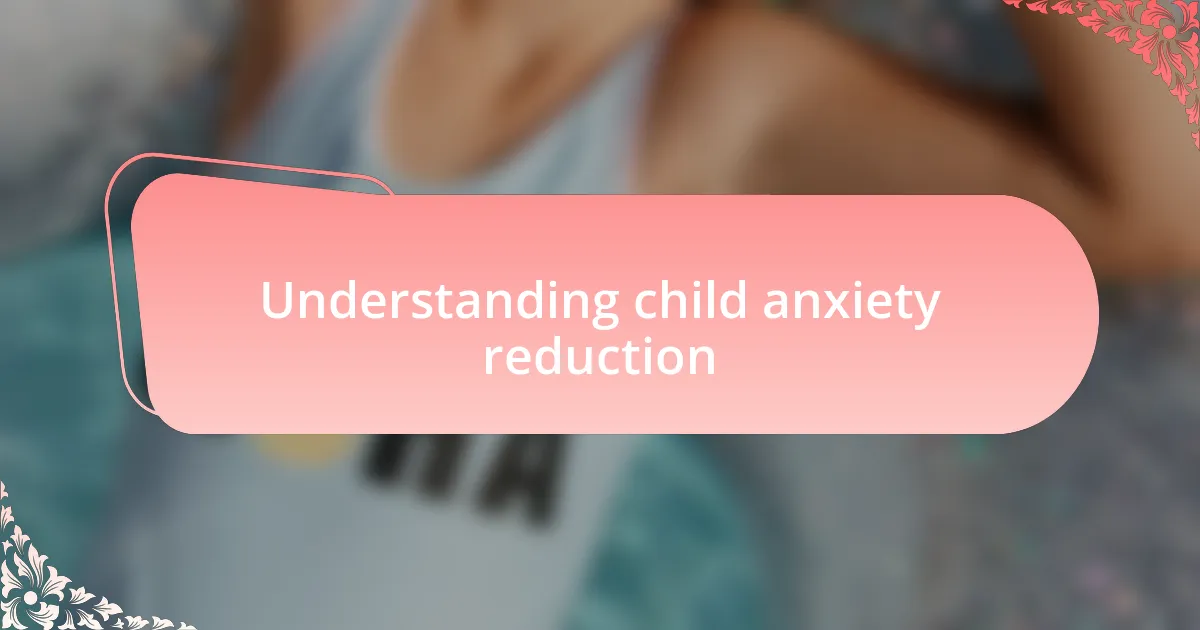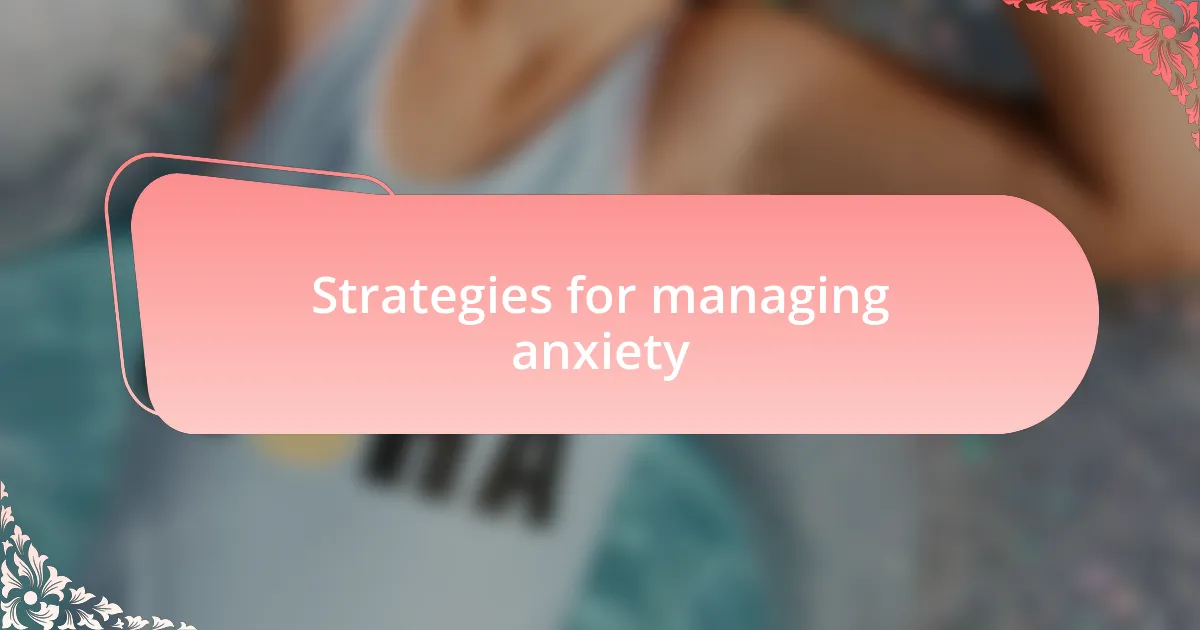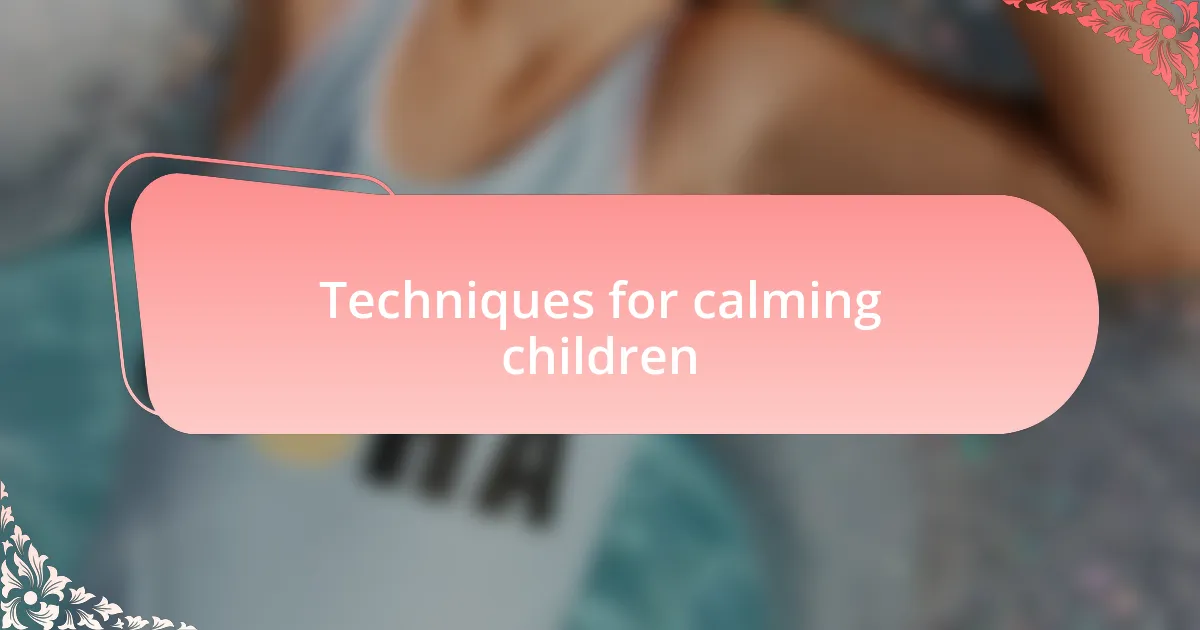Key takeaways:
- Open communication and creating a safe space for children to express their emotions are vital for managing anxiety.
- Establishing routines and predictability can significantly reduce anxiety levels in children.
- Engaging in creative activities, mindfulness, and physical movement offers effective techniques for calming anxious feelings.
- Access to child health support resources and early intervention plays a crucial role in nurturing children’s emotional well-being.

Understanding child anxiety reduction
Reducing anxiety in children requires a deep understanding of their unique emotional landscapes. I remember a time when my child faced overwhelming nervousness about an upcoming school performance. Instead of dismissing those feelings, we talked openly about what she was experiencing. This conversation helped her articulate her fears, making it easier to tackle them together.
One effective method I’ve seen is creating a safe space for children to express themselves. When my child struggled with anxiety, I encouraged her to use a feelings journal. This simple yet powerful practice transformed our home into a sanctuary where she could freely explore her emotions without judgment. Have you tried something similar? It can be eye-opening.
The role of routine cannot be understated when addressing anxiety in children. I observed that establishing consistent bedtime rituals significantly reduced my child’s worries. Predictability can be grounding for young minds, offering them a sense of control in an often chaotic world. How do you create comfort and predictability in your child’s life? Each small adjustment can make a meaningful difference.

Importance of child health support
Child health support is crucial in nurturing not just physical well-being but also emotional stability. I vividly recall attending a parenting workshop where the speaker emphasized the link between a child’s mental health and their overall development. It struck me how often we prioritize physical check-ups while mental wellness often takes a back seat. How often do we think about providing our children with the emotional tools they need just as much as we worry about their nutrition?
In my experience, having access to dedicated child health support resources can significantly empower parents. There was a time when my child had trouble managing her anxiety, and I felt lost until I discovered local support groups that offered guidance and strategies. The sense of community provided reassurance and valuable tools, reminding me I wasn’t alone in this journey. Have you sought out resources in your area that could help bolster your child’s emotional health?
Moreover, early intervention is a vital aspect of child health support that can change the course of a child’s life. I remember one particularly poignant story from a fellow parent whose child received timely counseling, leading to remarkable improvements in both academics and social interactions. It really hit home for me that the sooner we address mental health issues, the more resilient our children can become. What steps have you considered taking to ensure your child receives the support they need?

Strategies for managing anxiety
When it comes to managing anxiety, one effective strategy I’ve found is incorporating mindfulness into our daily routine. During that time when my child experienced frequent anxiety, we started practicing simple breathing exercises together. I remember how, after just a few minutes of focused breathing, I could see the tension melt away from her shoulders. Have you ever tried mindfulness techniques? They can create a calming space that is often hard to find in the chaos of everyday life.
Another approach that has worked for us is creating a structured environment at home. I noticed that when we established a predictable schedule for activities, my child’s anxiety levels significantly decreased. Each evening, we would sit down and plan the next day’s events, which helped her feel more in control and less overwhelmed. Have you considered how routine might bring comfort to your child? It can offer reassurance that while life may feel unpredictable, some aspects remain steadfast.
Lastly, I’ve learned the importance of open communication about feelings. There was a moment when my child hesitated to express her worries, fearing it might upset me. I encouraged her to share her thoughts openly by creating a safe space for dialogue, where no concern was too small or trivial. This has fostered an emotional intimacy that allows her to feel heard and supported. How might discussing feelings in your household change your child’s approach to anxiety? It’s a powerful step toward resilience.

Techniques for calming children
One technique that has been remarkably effective for calming my child is engaging in creative activities together. I vividly recall one afternoon when we pulled out the art supplies and started painting. As we smeared colors across the canvas, I could see her worries fade as she whispered about each stroke, immersing herself in the moment. Have you ever noticed how creativity can transport a child, providing a much-needed escape from their anxious thoughts?
Another approach I’ve found helpful is using calming music as a backdrop during stressful times. There was a particularly tense evening when my child was struggling to settle down for bedtime. I decided to play some soothing melodies, and as we listened together, I saw her body relax. It was a quiet reminder of how sound can soothe the spirit. Have you tried using music to create a calming atmosphere at home? It could be just the key to easing your child’s anxiety.
Lastly, introducing physical activities has made a significant difference in managing anxiety levels. One day, we took a short nature walk, and I found that simply being outside and moving helped my child release pent-up energy. As we strolled, we talked about the trees and the sky, distracting her from her worries. Do you think a little movement or fresh air might help your child find peace amidst anxiety? I’ve realized that sometimes, changing our surroundings and getting active can unlock a better mindset.

Activities that reduce anxiety
One activity that I’ve seen work wonders in reducing anxiety is engaging in guided yoga together. I remember a particular evening when we followed a simple yoga routine designed for kids. As we moved through gentle poses, my child began to mirror the calmness we were cultivating, her breathing slowing alongside mine. Isn’t it fascinating how movement, paired with mindfulness, can create a serene escape from anxious thoughts?
Joining in on some gardening activities has also been a surprisingly effective way to alleviate stress. I reflect on a day when we planted flowers in our backyard. With each seed we placed in the soil, I could almost see my child’s tension melt away, replaced by a sense of purpose and connection to nature. Could the act of nurturing something growing help your child feel more grounded and at ease, like it did for us?
Lastly, I find that storytelling can be a magic remedy for anxious moments. When I shared a captivating tale with my child, I watched her lean in, captivated by the plot. Her worries faded as she became invested in the characters, momentarily escaping her own fears. Have you ever experienced the incredible power of a good story to transport someone to a different world, providing comfort and relief from anxiety? I believe it can create a powerful bond while highlighting the beauty of imagination.

Personal experiences in anxiety reduction
One of my personal go-tos for reducing anxiety has been baking together. I remember a rainy afternoon, feeling the weight of stress pressing down on both of us. As we mixed flour and sugar, I could see the tension in my child’s shoulders drop with each stir of the batter. Do you notice how simple tasks like this can transform the mood in your home? It’s like creating something delicious together provides us with both focus and joy.
I’ve also found that taking short, mindful walks has a remarkable effect on both of our mental states. There was a time when we wandered through a nearby park, observing the changing leaves and listening to the crunch of twigs underfoot. With each step, I felt our worries dissolve, replaced by the refreshing scent of nature. Doesn’t taking a moment to connect with the outdoors help ground both you and your child, pulling you out of a spiral of anxious thoughts?
Journaling has emerged as a surprisingly powerful tool for us too. One evening, I encouraged my child to write down her feelings, and I joined her with my own journal. As we scribbled away, I noticed how the act of putting thoughts to paper seemed to lift a weight off our chests. Isn’t it fascinating how expressing our emotions can foster a sense of relief and clarity?

Creating a supportive environment
Creating a supportive environment plays a vital role in managing anxiety. I recall one evening when we decided to turn our living room into a cozy reading nook. We gathered blankets and pillows, making it feel like a safe haven. As we settled in with our books, I noticed a sense of comfort enveloping us, as if the space itself was wrapping us in a warm embrace. Have you ever felt how a change in surroundings can influence your mood and mindset?
Another powerful factor for us has been establishing routines. I remember when we implemented a “winding down” ritual before bedtime, which included soft music and sharing something we were grateful for. This simple practice transformed our evenings into a time of connection rather than chaos. It made me wonder—could a predictable routine create a sense of security in an otherwise unpredictable world?
Finally, I’ve discovered the importance of open communication in our supportive environment. There was a time I sat down with my child after a particularly anxious day at school. We had an honest discussion about her feelings, and I felt a wall of worry begin to crumble as she expressed herself. Isn’t it remarkable how just talking about our experiences can cultivate understanding and reassurance, creating a safe space for our loved ones to thrive?